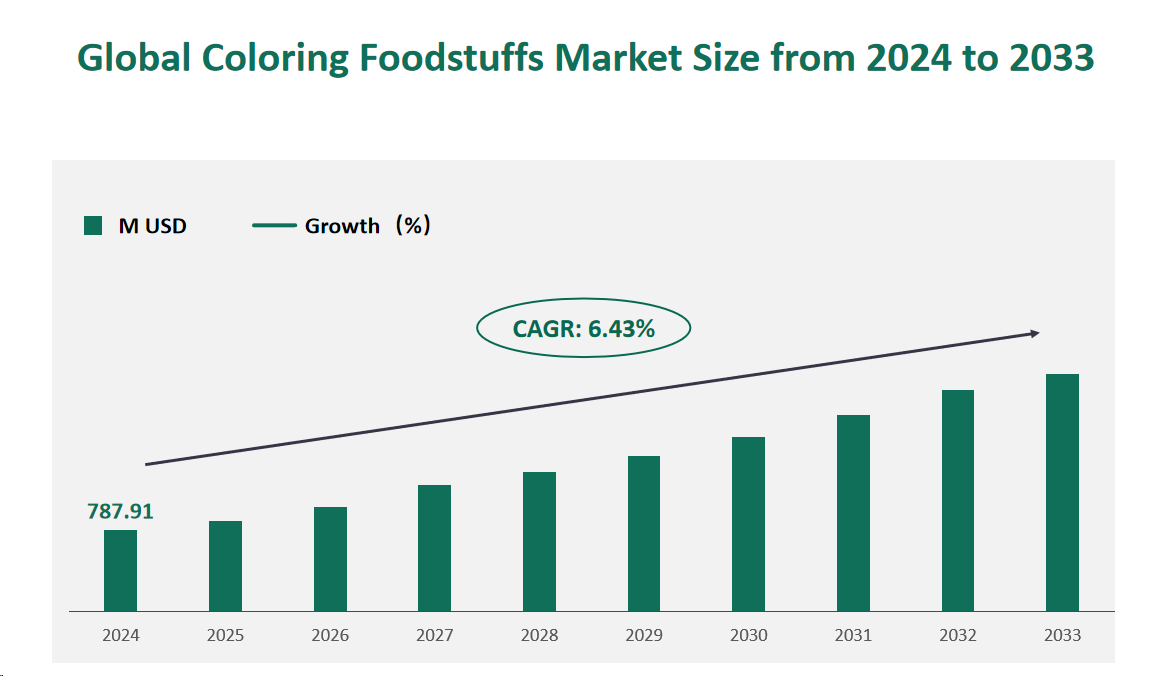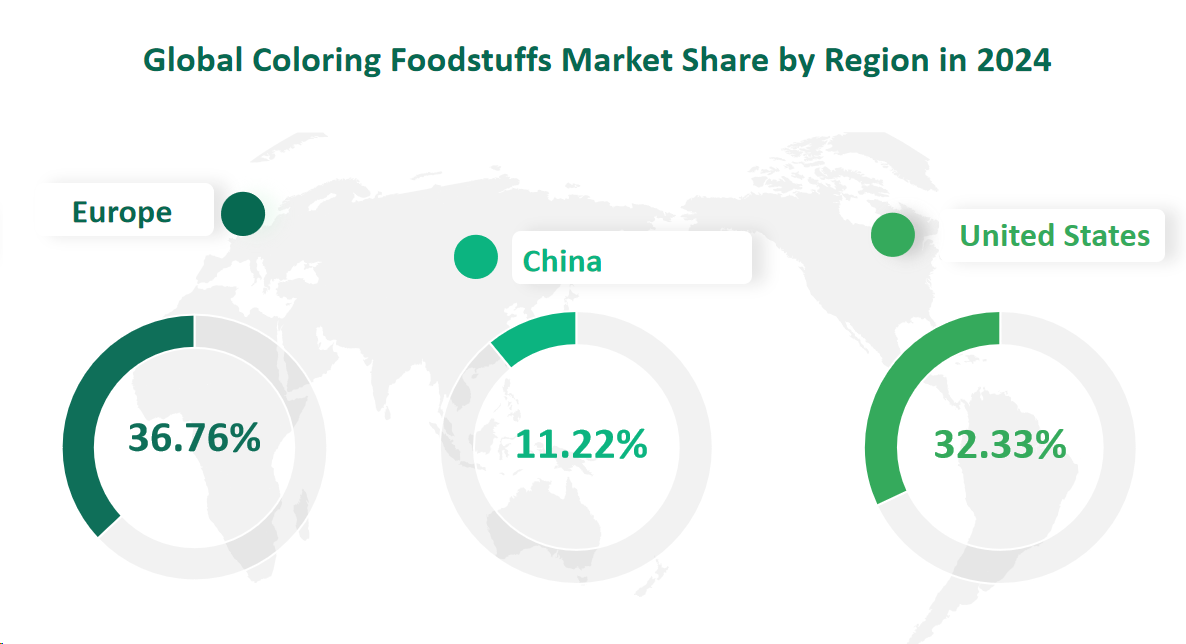1 Global Coloring Foodstuffs Market Size (Value) and CAGR (2024-2033)
The global Coloring Foodstuffs market is projected to experience significant growth in the coming years, with a total market value estimated to reach $787.91 million in 2024. This represents a Compound Annual Growth Rate (CAGR) of 6.43% from 2024 to 2033.
Coloring foodstuffs, also known as color from food or natural food colors, are derived from edible fruits, vegetables, flowers, algae, and spices. These ingredients are processed using physical methods such as pressing, crushing, and filtering, without the use of chemicals or solvents to extract pigments, ensuring a clean label status and meeting the growing consumer demand for natural and healthy food products.
Figure Global Coloring Foodstuffs Market Size (M USD) and CAGR 2024-2033

2 Drivers and Challenges of the Coloring Foodstuffs Market
The Coloring Foodstuffs market is experiencing a period of significant growth, driven by various factors and simultaneously facing a set of challenges. One of the primary drivers is the expanding food and beverage industry, which is a critical part of daily life and has seen its market scale grow due to economic development and urbanization. This growth directly influences the demand for coloring foodstuffs, which enhance the sensory properties of food, increasing color appeal and stimulating appetite.
Additionally, there is a growing demand for natural health products as consumers become more health-conscious. There is a notable shift towards natural, nutritious, and green food, leading to a decrease in the use of artificial food colorants and an increase in the popularity of coloring foodstuffs, which are perceived as more natural and healthy.
Another driver is the emerging market trends in the Asia-Pacific region, where the large population base and rapid economic development contribute to the continuous expansion of the food and beverage market. This region’s focus on natural products and food safety further boosts the demand for coloring foodstuffs. However, the market faces challenges such as the unstable supply of raw materials, which are inherently cyclical, regional, and seasonal. Natural disasters and climate conditions can significantly affect the supply and prices of these raw materials, leading to fluctuations in the coloring foodstuffs market.
3 Emerging Market Trends and Consumer Preference Analysis in the Coloring Foodstuffs Market
Emerging market trends indicate a shift towards the Asia-Pacific region as a key driver of the coloring foodstuffs market. This region’s food and beverage industry is growing rapidly, and with it, the demand for coloring foodstuffs that improve the visual appeal of food and beverages.
Consumer preferences are also leaning towards bolder colors, as they stimulate the desire to purchase. Companies in the food and beverage industry are more inclined to cooperate with coloring foodstuffs companies that offer bright and vibrant colors, as these are more attractive to consumers. However, price and product stability are also critical factors in their selection process.
Due to concerns about the health risks of synthetic colors, people are increasingly turning to natural products. Many major food companies have pledged to limit the use of artificial additives and colorants in their products. For instance, Kraft removed artificial preservatives, flavors, and dyes from its macaroni cheese recipe, replacing them with natural flavors like paprika, annatto, and turmeric.
This shift towards natural coloring foodstuffs is expected to continue as health consciousness and sustainability become more significant factors in consumer purchasing decisions. The market for coloring foodstuffs is also influenced by the impact of regional situations and inflation, which can affect raw material supply, energy costs, and consumer purchasing power.
4 Global Coloring Foodstuffs Market Size and Share by Type in 2024
The global coloring foodstuffs market is anticipated to be segmented into various types, each contributing significantly to the overall market value.
Fruits: Expected to hold a market value of $293.26 million in 2024, fruits-derived coloring foodstuffs are set to decrease slightly in market share to 37.22%. These products are made from a variety of fruits such as grapes, elderberries, blueberries, and strawberries, which are processed to extract pigments that impart color to food and beverages without the use of chemicals or solvents.
Vegetables: With a forecasted market value of $333.68 million, vegetables-derived coloring foodstuffs are predicted to be the largest segment, capturing a 42.35% share of the market. Coloring foodstuffs from vegetables like carrots, pumpkins, tomatoes, and beets are popular for their vibrant hues and natural origin.
Cereals: Projected to have a market value of $66.63 million, cereals-derived coloring foodstuffs are expected to maintain a steady growth, with an 8.46% market share. These products are made from grains such as black rice and corn, offering a range of colors derived from natural sources.
Herbs and Spices: Expected to generate a market value of $60.91 million, herbs and spices-derived coloring foodstuffs are forecasted to have a 7.73% market share. Coloring foodstuffs from herbs and spices like saffron, ginger, and chili are valued for their intense flavors and colors.
Table Global Coloring Foodstuffs Market Size and Share by Type in 2024
Type | Market Size (M USD) 2024 | Market Share 2024 |
Fruits | 293.26 | 37.22% |
Vegetables | 333.68 | 42.35% |
Cereals | 66.63 | 8.46% |
Herbs and Spices | 60.91 | 7.73% |
Others | 33.43 | 4.24% |
5 Global Coloring Foodstuffs Market Size and Share by Application in 2024
The global coloring foodstuffs market is anticipated to be segmented into various applications, each contributing significantly to the overall market value.
Bakery, Snacks, & Cereal: Expected to hold a market value of $173.50 million, this application segment is projected to decrease slightly in market share to 22.02%. Coloring foodstuffs in this category are used to enhance the visual appeal of bread, snacks, and cereal products, with ingredients like turmeric providing a yellow hue to cakes and breads.
Beverage: With a forecasted market value of $218.54 million, beverages are expected to capture the largest market share at 27.74%. Coloring foodstuffs are used in a variety of beverages, including juices, sports drinks, and carbonated drinks, with ingredients like carrot juice providing an orange-red color.
Confectionery: Projected to have a market value of $194.38 million, confectionery is expected to hold a 24.67% market share. Coloring foodstuffs are used in candies, chocolates, and gummies, with strawberry juice concentrate giving candies a red color.
Dairy: Expected to generate a market value of $66.30 million, dairy products are forecasted to have an 8.41% market share. Beet juice gives some ice cream a pink color, and concentrates of various orange carrots give dairy products a near-reddish-orange color.
Meat, Poultry, Fish, & Eggs: Projected to have a market value of $58.59 million, this application segment is expected to capture a 7.44% market share. Paprika gives some sausages a red color, and beet juice gives some hams a pink color.
Table Global Coloring Foodstuffs Market Size and Share by Application in 2024
Application | Market Size (M USD)2024 | Market Share 2024 |
Bakery, Snacks, & Cereal | 173.50 | 22.02% |
Beverage | 218.54 | 27.74% |
Confectionery | 194.38 | 24.67% |
Dairy | 66.30 | 8.41% |
Meat, Poultry, Fish, & Eggs | 58.59 | 7.44% |
Others | 76.62 | 9.72% |
6 Global Coloring Foodstuffs Market Size and Share by Region in 2024
The global coloring foodstuffs market is distributed across various regions, each with its unique market dynamics.
United States: Expected to hold a market value of $254.73 million, the United States is expected to capture the second-largest market share at 32.33%.
Europe: With a forecasted market value of $289.64 million, the Europe is projected to lead the market with a 36.76% share. The region’s strict regulations on food additives and a preference for natural ingredients drive the market for coloring foodstuffs.
China: Projected to have a market value of $88.40 million, China is expected to have an 11.22% market share. The growing middle class and increasing health consciousness are fueling the demand for natural coloring foodstuffs in the region.
Japan: Expected to generate a market value of $35.53 million, Japan is forecasted to have a 4.51% market share. The country’s aging population and focus on health and wellness contribute to the demand for natural food products.
India: Projected to have a market value of $17.73 million, India is expected to capture a 2.25% market share. The growing population and expanding food industry present opportunities for coloring foodstuffs in the region.
Southeast Asia: With a market value of $19.07 million, Southeast Asia is anticipated to account for 2.42% of the total market. The region’s economic growth and increasing demand for natural food products are driving the market.
Latin America: Projected to have a market value of $31.12 million, Latin America is expected to capture a 3.95% market share. The region’s growing food industry and consumer preference for natural ingredients are contributing to the market growth.
Middle East and Africa: Expected to generate a market value of $33.09 million, the Middle East and Africa are forecasted to have a 4.20% market share. The region’s developing food industry and increasing awareness of natural food products are driving the demand for coloring foodstuffs.
Figure Global Coloring Foodstuffs Market Share by Region in 2024

7 Major Players in Global Coloring Foodstuffs Market
7.1 GNT International B.V.
Company Profile: Established in 1978 and headquartered in the Netherlands, GNT International B.V. operates worldwide under the brand EXBERRY®, offering a range of coloring foods made from fruits, vegetables, and edible plants using physical manufacturing processes. The company is renowned for its natural color solutions and full raw material traceability.
Business Overview: GNT Group is a leading global provider of Coloring Foods, manufacturing concentrates from edible fruits, vegetables, and plants without the use of artificial additives, chemicals, or organic solvents. Their products are used in various food applications, including confectionery, bakery products, dairy products, and beverages.
Product Offered: The flagship product, EXBERRY®, provides truly natural color solutions suitable for vegetarian, vegan, kosher, and halal diets, with support through each step of the commercialization process.
Financial Performance in 2024: GNT International B.V. reported a revenue of $168.96 million with a gross margin of 43.52%.
7.2 Oterra
Company Profile: Oterra, founded in 1874 and based in Denmark, has a global sales reach. The company is known for its naturally sourced colors for the food, beverage, dietary supplements, and pet food industry.
Business Overview: Oterra specializes in producing natural coloring ingredients used in dairy and fruit preparations, confectionery, ice cream, prepared foods and beverages, focusing on the conversion from artificial to natural colorants.
Product Offered: Their product, FruitMax®, is made from a variety of fruit, vegetable, and plant concentrates, processed using gentle methods, supporting clear and simple labeling on food and beverage products.
Financial Performance in 2024: Oterra achieved a revenue of $131.21 million with a gross margin of 45.02%.
7.3 Naturex S.A.
Company Profile: Naturex S.A., established in 1992 and headquartered in France, operates globally, offering a portfolio of natural specialty ingredients for the food and health industries.
Business Overview: Naturex sources, manufactures, and markets natural specialty ingredients, including colors, natural preservation ingredients, specialty fruits & vegetables, phytoactives, and other plant-based natural ingredients, helping customers switch to natural ingredients.
Product Offered: Vegebrite® Ultimate Spirulina, derived from a blue-green alga, is one of their key products, offering all shades of blue and green for clean-label friendly formulations.
Financial Performance in 2024: Naturex S.A. reported a revenue of $108.93 million with a gross margin of 40.71%.

